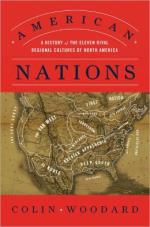 I read a great article by Colin Woodard over at Ten Miles Square, Violence Is a Regional Issue. It is based on the work in his book, American Nations. In it, he divides the United States up into eleven regional cultures. I haven’t gotten the book yet, but he provides historical and sociological reasons why the the regions are different.
I read a great article by Colin Woodard over at Ten Miles Square, Violence Is a Regional Issue. It is based on the work in his book, American Nations. In it, he divides the United States up into eleven regional cultures. I haven’t gotten the book yet, but he provides historical and sociological reasons why the the regions are different.
For example, he notes that “Puritans, Quakers, and Dutch farmer-artisans” settled the northeast and the midwest. Their sense of working together for the common good resulted in a more liberal culture. Compare this to the deep south that was settled by “swashbuckling Cavaliers of noble or landed gentry status, who took their values… from the knightly, medieval standards of manly honor and virtue.” Hence the conservative attitude of that region, “Every man for himself and if you become a slave, well, you deserve it!”
What most struck me was this map:

In my lifetime, I’ve only ever lived in three places for any amount of time: San Francisco, Portland, and Settle. So The Left Coast really stuck out to me because Woodard is absolutely correct: we are a distinct culture. And although we share a lot with our El Norte neighbors below, we are distinct from them. And we are utterly distinct from The Far West. So I’m inclined to take his theory very seriously and I look forward to reading the book.
Most of the article is simply about another piece Woodard wrote, Up in Arms. You should check out the whole article because he describes each of the regions. But he highlights how conservative areas are also more violent: both in terms of legal and illegal violence:
Kieran Healy, a Duke University sociologist, broke down the per capita, age-adjusted deadly assault rate for 2010. In the northeastern states—almost entirely dominated by Yankeedom, New Netherland, and the Midlands—just over 4 people per 100,000 died in assaults. By contrast, southern states—largely monopolized by Deep South, Tidewater, and Greater Appalachia—had a rate of more than 7 per 100,000. The three deadliest states—Louisiana, Mississippi, and Alabama, where the rate of killings topped 10 per 100,000—were all in Deep South territory. Meanwhile, the three safest states—New Hampshire, Maine, and Minnesota, with rates of about 2 killings per 100,000—were all part of Yankeedom.
Not surprisingly, black Americans have it worse than whites. Countrywide, according to Healy, blacks die from assaults at the bewildering rate of about 20 per 100,000, while the rate for whites is less than 6. But does that mean racial differences might be skewing the homicide data for nations with larger African-American populations? Apparently not. A classic 1993 study by the social psychologist Richard Nisbett, of the University of Michigan, found that homicide rates in small predominantly white cities were three times higher in the South than in New England. Nisbett and a colleague, Andrew Reaves, went on to show that southern rural counties had white homicide rates more than four times those of counties in New England, Middle Atlantic, and Midwestern states.
The pattern for capital punishment laws is equally stark. The states dominated by Deep South, Greater Appalachia, Tidewater, and the Far West have had a virtual monopoly on capital punishment. They account for more than ninety-five percent of the 1,343 executions in the United States since 1976. In the same period, the twelve states definitively controlled by Yankeedom and New Netherland—states that account for almost a quarter of the U.S. population—have executed just one person.
He doesn’t make any value judgments about this. But it is interesting that the regions of the United States that are most inclined to consider themselves the “real America” are the places that are the most violent and intolerant. Think about that they next time you hear Sarah Palin or Ted Cruz demagogue about Red State America.






Very interesting, and now on my library list. (And yes, I am testy today. Like most days, really.)
Living in Portland, you might or might not have spent any time visiting the high desert east off the Cascades. Which is very different, politically. It wasn’t until a few years ago that I learned most towns east of the Cascades were settled much later than the Willamette Valley. Oregon Trail settlers went to the Valley, it had the best farmland. Eastern Oregon was settled, largely, by ex-Confederates after the war; by then, most of the Valley’s farmland had been claimed. Hence the resistance to government, the hatred of educated elites, etc. William Kittredge writes beautifully about growing up out there; Benjamin Percy’s "The Wilding" is "Deliverance" set in Eastern Oregon.
It’s getting better over there, now. I visited a few years back. Every farm had a "For Sale" sign on it. Maybe it was because my drivers’ license read "Minnesota" instead of "Portland," I met many people eager for my tourism dollar and happy to chat briefly about their day-to-day lives. (20 years ago, flashing that "Portland" ID was tantamount to the Eastern dude ordering a glass of warm milk in the cliched Western-movie bar; voices stopped chattering, the piano stopped playing, and the whore whispered "I’d be mosey-ing along if I were you, mister.")
Things are changing. Some can adapt, and some can’t. Those small-scale ranches, where a handful of cows sleep in the sun next to the creek, either have to go organic and sell to elitists, or go under from competition with Big Ag. People are losing their way of life and many don’t understand why. I met some terrific people (including a lady from Minnesota who ran the motel in Burns!), but I also heard the foulest, most noxious talk radio of my adult life. It’s either hateful right-wing vitriol or apocalyptic Christian gibberish. I turned it off, put "Democracy" on repeat on my MP3 player, and cried for two hours to the Boise airport.
Here’s a fun story I saw about a little town in the Olympic peninsula. If you know that area, you’ll know it’s a logging economy where all the trees are gone, save the protected rainforest in the park. I’ve seen giant murals of gory, bleeding Jesus painted on the sides of public high-school gymnasiums out there. No joke. If you’re a arty, effeminate kid growing up out there, you’ll probably become the world’s biggest rock star and shoot your head off.
But wait! Seems there’s some life in the local economy after all. Turns out the "Twilight" novels, about teenage angst and vampires or something (my SO, who likes supernatural stuff, read half of one and said it was "glittery"), are set in the real town of Forks. So now thousands upon thousands of "Twilight" fans visit Forks:
http://www.avclub.com/articles/how-twilight-helped-keep-a-struggling-logging-town,104947/
What’s so great about this story is that fundamentalists (and I’ll guarantee you that’s 90% of the Olympic population) generally frown upon anything vampire-y, or having to do with magic. It’s witchcraft, you see, and Paul said that leads to the Devil. I have a friend whose kid dressed up as Harry Potter this Halloween, and who’s seen all the movies, but he wouldn’t read the books because fans told him they were involving and he worried about getting sucked into something vaguely Satanic. (My fundamentalist dad thought there was too much magic in "Star Wars"!)
But hey — money. So the good people of Forks have embraced their inner vampires. I hope they do well by it. You can still visit the town of Roslyn, WA, where the exteriors of "Northern Exposure" were shot, and buy all kinds of chintzy souvenir stuff. If the folks in Forks are smart, they’ll milk this "Twilight" thing for decades.
And that’s my non-testy story!
@JMF – As for the farmers: wisdom comes suddenly to some–as foreclosure. My wife and I spent some time out there. We were from Portland, but the people always seemed to think our money more than offset our city stain. (We were pretty high most of the time too, so that probably helped to make it seem nice.) Of course, the Mary Hill is over there (on the WA side), so that always brought out a lot of people like us. Otherwise, once you get out there you might as well be in Idaho or Montana. I never feel that comfortable outside of a city. I feel strange where I am now. I don’t trust the open space and the people who populate it.
My sister lived in Olympia, but that’s on the edge of the OP. Anyway, it is Olympia. It is like the Austin of Texas.
I don’t get the whole Satanic Harry Potter (or whatever) thing. To me, it is all about this fundamental belief of religious people that it’s dangerous to have fun. In [i]The Name of the Rose[/i] (an excellent novel if you haven’t read it), the key issue is that one person thinks that that laughter is an affront to God. That kind of thinking will always be around.
I tend to agree with your dad: the mystical basis of [i]Star Wars[/i] was very eastern and thus a kind of subtle attack on the Abrahamic religions. Sadly, the [i]Star Wars[/i] religion was a hell of a lot more advanced than the Christianity that most people follow!
I always liked Stonehenge, myself. The nutball millionaire, Sam Hill, thought recreating Stonehenge in min-size would be a huge tourist attraction, like the original. That the original drew tourists because of its age and connection to the past didn’t occur to Hill. (History? What? I have money!) He planned on Stonehenge drawing tourists, he built the Gorge highway to bring them there, and he built Maryhill for a Romanian princess 20-odd years his junior that he’d fallen in love with because he saw her one time.
(None of this is in the history books, but a 70+-year-old teacher I had as a kid told the story, and I have no reason to doubt the man. Everything else he ever told us turned out to be true, why not the Sam Hill story?)
I haven’t seen it in 20 years or so, but I remember Kurosawa’s "The Hidden Fortress" had two goofy characters a lot like the robots in "Star Wars," and a bad guy in a black helmet who becomes good right at the end. According to Wiki, Lucas has acknowledged his debt to that movie. So, yeah, it’s Eastern, Dad’s radar was accurate on that one. But, then, his radar was always pretty accurate for anything that challenged the Jesus, or His earthly surrogate (Dad.)
That’s the soul of what you describe as "the fundamental belief of religious people that it’s dangerous to have fun." You can have fun within the authoritarian structure; at church picnics, listening to Handel’s "Messiah," and what-not. But nothing outside the structure is acceptable.
I think I mentioned this before, but my dad was a early-60’s folk-scene guy. He was a childhood abuse victim, and never easygoing enough to enjoy the flip side of folk-music culture, the sex and drugs. (Plus something of a racist to his core, so when the folk revival and civil-rights movement locked elbows, that was that for him.) But he never stopped listening to the old stuff.
It’s still weird for me today, hearing old Dylan records or the Kingston Trio or the Clancy Brothers, and how so much of the lyrics are positively rebellious. ("For the love of one’s country is a terrible thing" — "The Patriot Game," trad., arranged by the Clancy Brothers.) As an adult once I played The Pogues’ "The Band Played Waltzing Matilda" for him; he hated the singer, but loved the song. And then I got to hear a lecture on why Clinton was the biblical Antichrist, prophesied by Revelations. Not a well man. (As kids we were allowed to listen to show tunes, because rock music might make us sexual deviants. So, yup, I know me all the showtunes. I can belt "I’m Just A Girl Who Can’t Say No" with the best of ’em.)
The other fun thing to revisit today, besides the old music, is old movies. In our home, anything that used the Lord’s name in vain or anything that showed unmarried characters doing the dirty deed was verboten. So any movie that fit the old Hayes Production Code was OK! And, while I missed much of the subtext as a kid, those movies are positively reeking in sex and drugs. When Bogart kisses a woozy chick and the image fades to black, she weren’t in her right mind and they didn’t stop kissing. And the gay characters! Peter Lorre sucks on an umbrella handle in "Maltese Falcoln," Martin Landau positively limp-wrists it all over "North By Northwest." I think the writers, performers, and directors of those movies had a lot of fun showing what they weren’t supposedly allowed to show.
End of rant. I had a crazy co-worker, many years ago, and only for a few days. He saw somebody’s copy of a "Potter" book, and told me he had a problem working anywhere where people read such stuff. After all, those books teach you how to cast Satan’s potent spells. I looked him in the eyes and intoned "Avada Kedavra" in my most menacing voice. He looked me right back, dumbfounded. "Nope," I said, "doesn’t work."
(Actually I only wished I did that. In reality I was just creeped out by his Satan’s spells comment. But isn’t the fantasy version better?)
Also, sorry to rant and ignore much of your post. Don’t like open spaces? Hmm, different strokes. Maybe because I grew up in the ratty, decaying po’-white-trash suburbs of Portland (still ratty to this day, still decaying, still definitely PWT), I like cities and empty places, both. (As a kid, I could go to the library, where lots of smart, helpful grownups were, or I could go down by the abandoned factories and throw rocks at stuff by myself.)
The human race’s best achievements have almost all come from city dwellers (more ideas floating around) and, unless we revert to some sort of hunter-gatherer existence (which wouldn’t be the worst thing), our least damaging environmental presence is the high-density urban one, where a lot of resources are shared.
It’s been a while, but every so often I like to go out to Eastern Oregon and just let my brain unwind. Every bluff with a layer of exposed igneous rock on top reminds you how old the planet is, and how meaningless one’s own personal failings are. I find this comforting.
The only places I feel really ill-at-ease are modern well-to-do suburbs. Giant acres of lawns to isolate everyone from everyone else, but lots of expectation that city-like social services will be provided. They give me the creeps!